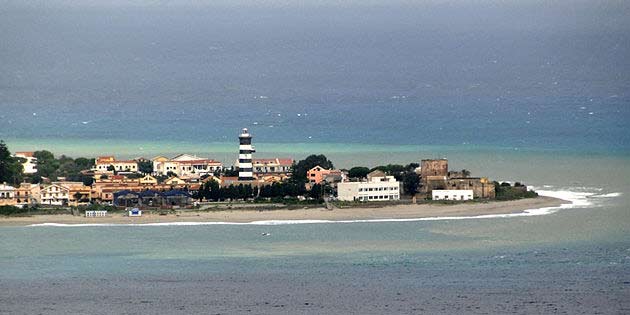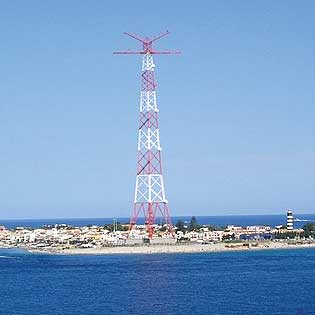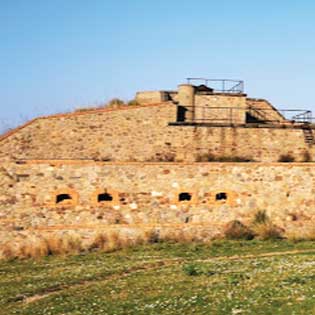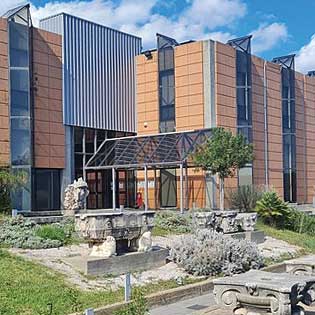Natural Reserve of Capo Peloro Lagoon
The Oriented Natural Reserve of Capo Peloro Lagoon is a protected natural area that extends in the extreme north-eastern part of the island, where the legendary sea monster of Charybdis once stood.
Capo Peloro is one of the points that somehow define the triangular perimeter of the island of Sicily. Near Syracuse, there is Capo Passero, the extreme north-eastern tip of the island, where the legendary sea monster of Charybdis once stood. In the territory of Marsala, there is Capo Lilibeo, at the extreme western tip of Sicily, where Lilibeo, an ancient Carthaginian city, once stood. These three Heads are linked by the legend of the three Nymphs and by the Myth of Tifeo.
Within the territory of the Reserve there are two seaside villages of great cultural and environmental richness: Torre Faro and Ganzirri; there is the Pylon of Torre Faro, a large disused pylon of the high voltage power line that crossed the strait and the Horcynus Orca Cultural Park.
Il The reserve's environmental heritage includes the large lake, the small lake and the beaches of Capo Peloro.
The Lago Grande, also known as Lago Ganzirri, was born from the merger of a smaller basin with the same name and another basin called Madonna di Trapani. In the melting zone, the seabed is very low and prevents the exchange of large masses of water, creating two different micro-environments. The lake is connected to the sea through two channels, while a third channel connects it with the adjacent lake of Faro. Together with Lake Faro, it has been declared an asset of ethno-anthropological interest because it is the site of traditional production activities related to shellfish farming, in particular to telliniculture.
The Lago Piccolo, also known as Lago Faro, is located north of Lake Ganzirri and is connected to it by a canal. The peculiarity of this environment is the persistent presence of hydrogen sulphide at depths greater than 10 m. This particularity has allowed the development of particular microorganisms that are able to metabolize sulfur derivatives at the interface between the ossic and anoxic zone. Together with Lake Ganzirri, it has been declared an asset of ethno-anthropological interest as it is the site of traditional production activities linked to shellfish farming, in particular mussel farming.
The beaches of Capo Peloro along the Tyrrhenian coast they are characterized by warmer and more rough waters, along the Ionian coast by colder and clearer waters. Of particular interest is the beach of Torre Faro, in the area under the Pilone, which offers multiple biodiversity in both flora and fauna. Of particular interest are the Beach Rocks, present on both sides, they are stretches of coast with hard and natural substrate, a unique case in the Mediterranean Sea, of considerable interest as it hosts extensive formations of biotypes protected at community level. Very characteristic of the place are the gusts, eddies generated by the current of the Strait of Messina, which in the past centuries animated the legend of Cariddi.
The Capo Peloro Reserve is one of the main nodes of the migration area of birds, many specimens of marine fauna and large cetaceans. Almost all species of birds of prey have been found in these places, including rare species such as the pale harrier, the white-tailed and steppe buzzard, the queen's falcon, the lanner and the Egyptian vulture. The Strait of Messina is also located along the main routes of the Mediterranean, so it is crossed by numerous marine species. Among these are the large pelagics, namely tuna, albacore, bonito, imperial aguglia and swordfish. It is also an obligatory point of passage for migrations and movements of cetaceans. Due to the trophic richness of the Strait it is verified that these fish transit in surface waters and can be captured with the particular boats called catwalks or feluccas, active only in this part of the Mediterranean. Finally of interest is the presence of selaceans that migrate across the Strait of Messina: the White Shark and the Capopiatto.
The flora of the reserve is concentrated around the lakes where you can observe a rich spontaneous vegetation as well as papyrus, palms, oleanders, reeds, maritime pines, eucalyptus trees, cypresses. In the lake, on the other hand, many types of algae proliferate. In particular, the presence of algae in the lake is such that, in early spring, the lake gives off unpleasant odors due to the presence of an abnormal mass of decomposing algae. This mass is so large that it hinders the passage of boats and the work of shellfish farmers, it is then collected and placed at the edge of the lake itself.



